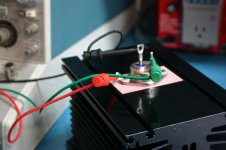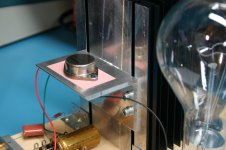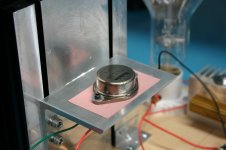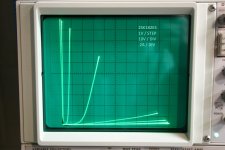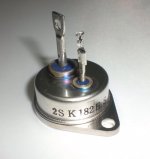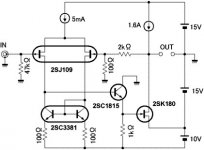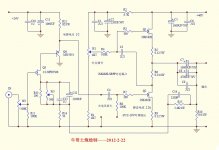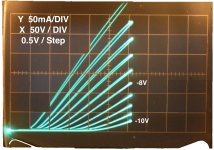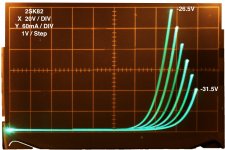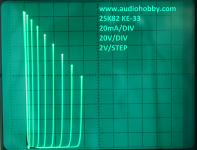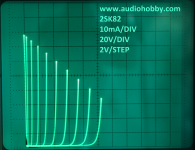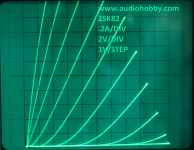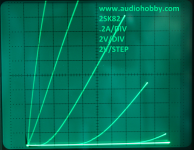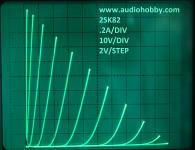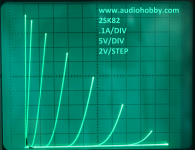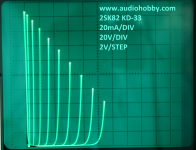Nice interesting photos Michael 
Many high fidelity aficionados dream about single triode characteristic stage with more power.
Simple 2SK82 l'Amp SIT give at output ~ 4 watts.
Could you describe little bit about potential of 2SK180 & 2SK182 ES ?
Linearity, gain, distortion, power from first hand experience not datasheet ?
Have a nice day. Best regards

Christophe

Many high fidelity aficionados dream about single triode characteristic stage with more power.
Simple 2SK82 l'Amp SIT give at output ~ 4 watts.
Could you describe little bit about potential of 2SK180 & 2SK182 ES ?
Linearity, gain, distortion, power from first hand experience not datasheet ?
Have a nice day. Best regards

Christophe
Last edited:
Dear Michael, how is the resistance of the lamp?
Here on Spain we are looking for this kind of lamps but only should get 125v /500W with E40 socket. Maybe We should use a couple in parallel.
One question, now I am getting more tools, I have only a scope and a generator, but the circuit for trace the curves, which circuit you made?
Best Regards
Best Regards for the rest of interested people waiting for the results from this amazing hobby.
Best Regards for Sound Happy my frenchi friend du Montpellier.
Best Regards for the Tiger Jama, my closest inspirer and friend.
Here on Spain we are looking for this kind of lamps but only should get 125v /500W with E40 socket. Maybe We should use a couple in parallel.
One question, now I am getting more tools, I have only a scope and a generator, but the circuit for trace the curves, which circuit you made?
Best Regards
Best Regards for the rest of interested people waiting for the results from this amazing hobby.
Best Regards for Sound Happy my frenchi friend du Montpellier.
Best Regards for the Tiger Jama, my closest inspirer and friend.
The 2SK180 seemed perfectly workable. I was seeing around .280% THD at a watt for the amp in the video, with THD around 1% at 4 watts. The big guy (NP) is working on something using this part, so I'll defer to him. I'm not gonna preempt the master.
The 2SK182ES I tested is pretty nasty. If you look at the curves, ideally we'd like those traces to be parallel and evenly spaced in the region where we intend to operate the device. When they're not, our output waveform gets squished and stretched, and this squishing and stretching causes harmonic distortion.
I beat on it pretty hard, running the current and voltage way up to see if I could get anything good out of it, but alas there are some problems even load line cancellation can't overcome. This might be a good part for a multi-kilowatt class A amp.
@dady
I used a Tektronix curve tracer to make those curves. I detailed a method to make curves with an improvised curve tracer in the original L'Amp article, but it's tedious and you must be careful.
2 300 Watt bulbs in parallel is about 11-13 Ohms.
I'll re-record the material with better sound and video and re-post something soon.
The 2SK182ES I tested is pretty nasty. If you look at the curves, ideally we'd like those traces to be parallel and evenly spaced in the region where we intend to operate the device. When they're not, our output waveform gets squished and stretched, and this squishing and stretching causes harmonic distortion.
I beat on it pretty hard, running the current and voltage way up to see if I could get anything good out of it, but alas there are some problems even load line cancellation can't overcome. This might be a good part for a multi-kilowatt class A amp.
@dady
I used a Tektronix curve tracer to make those curves. I detailed a method to make curves with an improvised curve tracer in the original L'Amp article, but it's tedious and you must be careful.
2 300 Watt bulbs in parallel is about 11-13 Ohms.
I'll re-record the material with better sound and video and re-post something soon.
Last edited:
The 2SK182ES I tested is pretty nasty.
Thanks for answer Michael.
Hope they become workable too !
Good luck in research of sweet spot and topology.
Personally don't need 2K watt but if posible this be " party time " amplifier for
out summer nights or just dozen watts in single-ended minimal way for long winter evenings.
Now i wait 2SK182 ES delivery from Tokyo
1pcs NEW Tokin Transistor 2SK182ES Made IN Japan Shipping Charge Free | eBay
7/50 on box is Tokin SIT grade or something other parameter ??
@ Dady Thanks Amigo have fun
Best regards to all diyers

Attachments
-
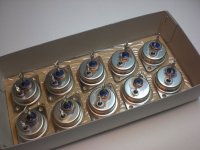 2CA87192-D4B0-4BAD-ADB6-CEC358A8F988.JPG384.3 KB · Views: 153
2CA87192-D4B0-4BAD-ADB6-CEC358A8F988.JPG384.3 KB · Views: 153 -
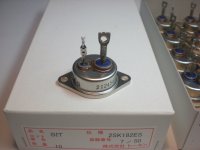 48F2C00D-721F-4781-91A3-0DE5BF436021.JPG280.4 KB · Views: 107
48F2C00D-721F-4781-91A3-0DE5BF436021.JPG280.4 KB · Views: 107 -
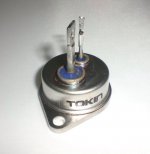 681E8CBD-B0A9-4227-9F41-E033EF2A7233.JPG50.7 KB · Views: 167
681E8CBD-B0A9-4227-9F41-E033EF2A7233.JPG50.7 KB · Views: 167 -
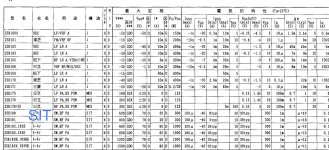 0F7A3CED-07FF-4A78-A0C4-C35326081E92.JPG629.2 KB · Views: 219
0F7A3CED-07FF-4A78-A0C4-C35326081E92.JPG629.2 KB · Views: 219 -
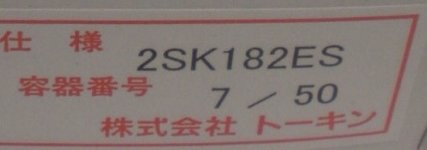 25E0FFE8-AB3C-4B55-B916-68638998EDB1.JPG24.4 KB · Views: 138
25E0FFE8-AB3C-4B55-B916-68638998EDB1.JPG24.4 KB · Views: 138
The 2SK180 seemed perfectly workable. I was seeing around .280% THD at a watt for the amp in the video, with THD around 1% at 4 watts. The big guy (NP) is working on something using this part, so I'll defer to him. I'm not gonna preempt the master.
Don't hold back for me. We are here for the benefit of DIY audio.
My amigo have showed me this topology with 2SK182 ES
http://www.diyaudio.com/forums/soli...t-sti-2sk182e-pipe-srpp-circuit-feasible.html
Thanks Dady
We have mimimalistic topology for sit amp with 2SK180 too
SIT Power Amplifier
L'Amp with biger sit´s are interesting upgrade.
with biger sit´s are interesting upgrade.
Just collected semis for next amp build
See you Michael at your Lab
Kindly regards
http://www.diyaudio.com/forums/soli...t-sti-2sk182e-pipe-srpp-circuit-feasible.html
Thanks Dady
We have mimimalistic topology for sit amp with 2SK180 too
SIT Power Amplifier
L'Amp
 with biger sit´s are interesting upgrade.
with biger sit´s are interesting upgrade.Just collected semis for next amp build
See you Michael at your Lab
Kindly regards
Attachments
Dear Michael, for all of us who follow attentively the steps in this thread on topic that is, circuits Engineer Nelson Pass which generously and think much as yourself that you work under its shade and always improving DIY community. Unfortunately you also had many expectations to find this monster SIT course, but now you're disappointed. The biggest problem is that as you worked in public and with all our attention, the phenomenon of disappointment was amplified. Now being tested may no curves in his home laboratory, trying to find the sweet spot, in order to find the unicorn in the debris of everyday life. You had suggested that this transistor may have a more transcendent linearity with other figures of current and voltage. I'm trying to read between the lines to test a practical concept resulting in the realization of these devices. The circuits out there and that are known to work are quite complex, come some of the EVOLVE website and some other scarce, from sites that publish diagrams Pleiades cascade transistor with current generators mirror the ones for most mortals who inhabit these DIY sectors are impracticable . I beg your patience Nerd, which characterizes you, Continues not give up, and transmit your results, what I'm sure, who are very close.
A greeting to the gentlemen of the thread, the topic and the forum.
A greeting to the gentlemen of the thread, the topic and the forum.
Last edited:
SIT curves at higher voltages
I'm attracted by SITs in general
and I got two questions.
I'm currently working on a 2SK82 based parafeed design (deeply inspired by DIYspaceW).
Nevertheless I was similarly attracted by an even "bigger" device and tried to get hold of a pair of 2SK180s.
Jama was exceptionally kind and send me a pair.
SITs are said to behave more linear and to have less capacitance at higher voltages. I therefore selected 140V/200mA as the OP for my 2SK82 parafeed prototype. This selection was additionally based on the SIT model available from M. Rothacher's homepage (described in Linear Audio #6).
The 2SK180 should allow even higher voltages. So, to start somewhere I tried (first time ever) to take some curves around a potential higher voltage OP for the 2SK180.
Applying the convincing simple methodology described by M. Rothacher in his L'amp article, I used a 230V/230V transformer, a SF4007 diode, a 10 Ohm resistor a bench power supply and the scope I inherited by my father in law to get the curves below.
Apologies for some slight misalignment of the different pictures, but I guess the main messages comes across:
- the devices impedance seems to vary to a considerable degree
- at higher gate voltages (starting from -7.5V) a hysteresis develops
Just to make sure I don't invest my time in a project that will not work, I took some further curves around the selected OP for the 2SK82. Lower gate voltages are varied here to stay below a maximal current of 360mA. These curves show the desired linearity (ok, lower range of measurements, but..) restoring my motivation to finish my 2SK82 amp.
My questions concluding this are:
- what might be the reason for the observed hysteresis of the 2SK180 (also observed in the original Sony 2SK82 data) ?
- Maybe the voltage of up to 310V is still to low for the 2SK180?
All the best,
Ulrich
I'm attracted by SITs in general
and I got two questions.
I'm currently working on a 2SK82 based parafeed design (deeply inspired by DIYspaceW).
Nevertheless I was similarly attracted by an even "bigger" device and tried to get hold of a pair of 2SK180s.
Jama was exceptionally kind and send me a pair.
SITs are said to behave more linear and to have less capacitance at higher voltages. I therefore selected 140V/200mA as the OP for my 2SK82 parafeed prototype. This selection was additionally based on the SIT model available from M. Rothacher's homepage (described in Linear Audio #6).
The 2SK180 should allow even higher voltages. So, to start somewhere I tried (first time ever) to take some curves around a potential higher voltage OP for the 2SK180.
Applying the convincing simple methodology described by M. Rothacher in his L'amp article, I used a 230V/230V transformer, a SF4007 diode, a 10 Ohm resistor a bench power supply and the scope I inherited by my father in law to get the curves below.
Apologies for some slight misalignment of the different pictures, but I guess the main messages comes across:
- the devices impedance seems to vary to a considerable degree
- at higher gate voltages (starting from -7.5V) a hysteresis develops
Just to make sure I don't invest my time in a project that will not work, I took some further curves around the selected OP for the 2SK82. Lower gate voltages are varied here to stay below a maximal current of 360mA. These curves show the desired linearity (ok, lower range of measurements, but..) restoring my motivation to finish my 2SK82 amp.
My questions concluding this are:
- what might be the reason for the observed hysteresis of the 2SK180 (also observed in the original Sony 2SK82 data) ?
- Maybe the voltage of up to 310V is still to low for the 2SK180?
All the best,
Ulrich
Attachments
You're sweeping a half-wave rectified sine, so your sweep goes up to the peak voltage then back to 0. Little things like interelectrode capacitances, and other effects (even temperature) could lead to those little loops. This is typical. Commercial curve tracers include various methods to help trim some of that out. But, they're really not a cause for alarm. In fact, I erased them out out of my original composite images, keeping the same half of the loop.
Last edited:
Nice job on the curves, by the way. I admire your willingness to endure a tedious task. Here's a whole bunch for the 2SK82 made on the Tek:
Attachments
.... Little things like interelectrode capacitances, and other effects (even temperature) could lead to those little loops. This is typical. .... But, they're really not a cause for alarm....
Dear Michael,
many thanks for this clear words on this. Seems it's good to have such a nice Tec device: don't know how long it would have taken me to explore the 2SK82 like you did and provided us with!
With the hysteresis judged as typical and no cause for alarm, I still tend to conclude that the 2SK82 seems more linear than the 2SK180, except I'm mistaken again (due to missing knowledge).
Many thanks for the additional curves,
Ulrich
Dear Urico, I think they have different transconductance and also different µ and the slope of the curve is good. With triodes is the same, 211 is more oblique than 845. The most important is the parallelism between. The hysteresis could be for many things, transformer, diode, etc. I don't remember but I almost sure than transformers are more proclivity, when the magnet transfer in the rising part of the hemicycle has hysteresis effect when you compare with the decaying part of the hemicycle. I will confirm with popilin.
- Status
- This old topic is closed. If you want to reopen this topic, contact a moderator using the "Report Post" button.
- Home
- Amplifiers
- Pass Labs
- Live Lab Hangout #1.1 Posted
